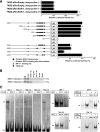Early growth response-1 induces and enhances vascular endothelial growth factor-A expression in lung cancer cells
- PMID: 20489156
- PMCID: PMC2893652
- DOI: 10.2353/ajpath.2010.091164
Early growth response-1 induces and enhances vascular endothelial growth factor-A expression in lung cancer cells
Abstract
Vascular endothelial growth factor-A (VEGF-A) is crucial for angiogenesis, vascular permeability, and metastasis during tumor development. We demonstrate here that early growth response-1 (EGR-1), which is induced by the extracellular signal-regulated kinase (ERK) pathway activation, activates VEGF-A in lung cancer cells. Increased EGR-1 expression was found in adenocarcinoma cells carrying mutant K-RAS or EGFR genes. Hypoxic culture, siRNA experiment, luciferase assays, chromatin immunoprecipitation, electrophoretic mobility shift assays, and quantitative RT-PCR using EGR-1-inducible lung cancer cells demonstrated that EGR-1 binds to the proximal region of the VEGF-A promoter, activates VEGF-A expression, and enhances hypoxia inducible factor 1alpha (HIF-1alpha)-mediated VEGF-A expression. The EGR-1 modulator, NAB-2, was rapidly induced by increased levels of EGR-1. Pathology samples of human lung adenocarcinomas revealed correlations between EGR-1/HIF-1alpha and VEGF-A expressions and relative elevation of EGR-1 and VEGF-A expression in mutant K-RAS- or EGFR-carrying adenocarcinomas. Both EGR-1 and VEGF-A expression increased as tumors dedifferentiated, whereas HIF-1alpha expression did not. Although weak correlation was found between EGR-1 and NAB-2 expressions on the whole, NAB-2 expression decreased as tumors dedifferentiated, and inhibition of DNA methyltransferase/histone deacetylase increased NAB-2 expression in lung cancer cells despite no epigenetic alteration in the NAB-2 promoter. These findings suggest that EGR-1 plays important roles on VEGF-A expression in lung cancer cells, and epigenetic silencing of transactivator(s) associated with NAB-2 expression might also contribute to upregulate VEGF-A expression.
Figures




References
-
- Ferrara N, Davis-Smith T. The biology of vascular endothelial growth factor. Endocr Rev. 1997;18:4–5. - PubMed
-
- Neufeld G, Cohen T, Gengrinovitch S, Poltorak Z. Vascular endothelial growth factor (VEGF) and its receptors. FASEB J. 1999;13:9–22. - PubMed
-
- Gale NW, Yancopoulos GD. Growth factors acting via endothelial cell-specific receptor tyrosine kinases: vEGFs, angiopoietins, and ephrins in vascular development. Genes Dev. 1999;13:1055–1066. - PubMed
-
- Ferrara N, Gerber HP, LeCouter J. The biology of VEGF and its receptors. Nat Med. 2003;9:669–676. - PubMed
-
- Fontanini G, Vignati S, Boldrini L, Chine S, Silvestri V, Lucchi M, Mussi A, Angeletti CA, Bevilacqua G. Vascular endothelial growth factor is associated with neovascularization and influences progression of non-small cell lung carcinoma. Clin Cancer Res. 1997;3:861–865. - PubMed
Publication types
MeSH terms
Substances
LinkOut - more resources
Full Text Sources
Medical
Research Materials
Miscellaneous

